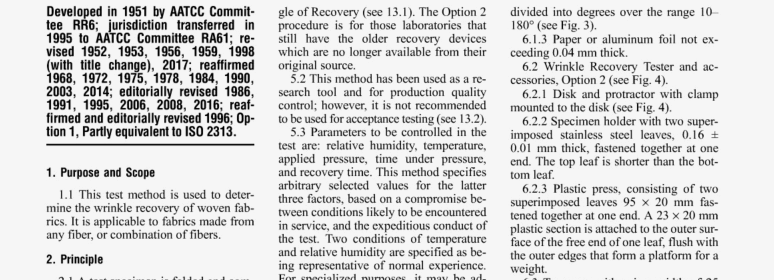Wrinkle Recovery of Woven Fabrics

AATCC 66-2017 pdf free.Wrinkle Recovery of Woven Fabrics: Recovery Angle.
Align thc holder with thc front edge of the clip mount shelf. The specimen fold should line up with the spot at thc center of thc recorder disk leaving the free hanging leg of the specimen aligned with the vertical guide linc on the scale. Takc special care to not touch, blow on or jam the specimen against the face of the recorder, Perform all operations as rapidly as possiblc. Repeat steps 9.2.4 and 9.2.4.1 for the second specimen, starting 60 ± 2 s after the weight is removed from the first specimen. Repeat all steps for the third specimen. 60 ± 2 s after the weight was removed from the second specimen.
To eliminate gravitational effects. keep the free hanging leg of the spccimcn aligned with the recorder’s ertical guide line during the 5 mm ± 5 s recoveiy period. Adjust every IS ± I s for die first minutc, and once a minute thereafter during the remaining recovery period. Make the Imal adjustment 15 ± I s before the 5 mm ± 5 s recovery period ends. A procedure to run continuous specimen testing is given in 13.5.
Read and record the recovery angle from the scale 5 mm 5 s after inserting a specimen into the clip mount on the recorder. If the free end of a specimen twists, sight a vertical plane through its center and align ii with the vertical mark on the recorder scale. Read and record die recovery angle for each specimen after it has been inserted in the clip mount for5min+5 s.
Repeat all steps for three specimens in the opposite direction and for specimens folded face-to-back in both fabric directions.
Calculate the average recovery in degrees for each group of three specimens; warp folded face-to-face; warp folded back-to-back; filling folded face- to-face; and filling folded back-to-back.
If the difference between face-to- face and back-to-back averages is not greater than 15°, average all warp readings and all filling readings separately. If the difference between face-to-face and hack-to-back averages is greater than 159, report the four averages separately.
State that the tests were performed as directed in AATCC Test Method (TM) 66, Option I or Option 2.Report the average warp and filling (or when necessary warp-face, warpback, flling-face and flling-back) recovery angles.
If other testing atmospheres are used, report the conditions under which the test was perfonned with the average values.
Precision and Bias In 2016. an inter-laboratory study was conducted comparing Option I to Option 2, Five laboratories participated in the study. Two of the participating laboratories performed Option I (Lab A: 3 technicians; Lab B: 3 technicians), two other bboratoncs performed Option 2 (Lab D: I technician; Lab E: 3 technicians), and the fifth laboratory (I .ab (technicians) performed both Options I and 2. For the study. three different fabrics (100% (‘elton Twill. Color Khaki; SI 419 Cotton Broadcloth, BIcachcd!sicrv:
and S/7465 50150 PolylCotton Print (‘loth) were each treated with five finishes (Finish I. No chemical; Finish 2. Softener only; Finish 3. 6% resin + softener; Finish 4. 12% resin + softener; and Finish 5. IK% resin -4- softcncr). Each test was performed using five face-to-face and five hack-to-back determinations in warp and filling directions.
Results of i-test performed to determine the statistical significance of the mean values produced by Option I and Option 2 arc shown in Table I. It can be seen that the mean and standard dcvialion values of Option I differ from the mean and standard deviation values of Option 2. A p-value of 0.000 for the two- sample t-tcst suggests that there is 0% probability for Option I results to be statistically similar to Option 2 results. The results, therefore are significantly different at 95% confidence level. Therefore. laboratories using Option I should not compare their results with that of laboratories using Option 2.
Within-!ahorutorv and hn%eenIabw-usorv data for Option I.
WiIhin-laboragor)’ and berwetn-hjhoralorv precision data for Option I. with specimens ranging from I to 6 is given in Table II. The precision values capture the variability contributed by the participating laboratories and their rcspcctivc operators.AATCC 66 pdf download.Wrinkle Recovery of Woven Fabrics